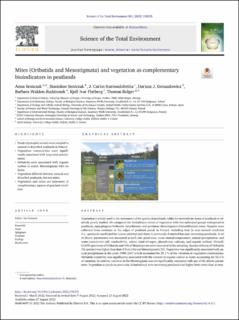| dc.contributor.author | Seniczak, Anna | |
| dc.contributor.author | Seniczak, Stanislaw | |
| dc.contributor.author | Iturrondobeitia, J. Carlos | |
| dc.contributor.author | Gwiazdowicz, Dariusz J. | |
| dc.contributor.author | Waldon-Rudzionek, Barbara | |
| dc.contributor.author | Flatberg, Kjell Ivar | |
| dc.contributor.author | Bolger, Thomas | |
| dc.date.accessioned | 2022-11-25T08:45:31Z | |
| dc.date.available | 2022-11-25T08:45:31Z | |
| dc.date.created | 2022-09-02T14:24:52Z | |
| dc.date.issued | 2022 | |
| dc.identifier.issn | 0048-9697 | |
| dc.identifier.uri | https://hdl.handle.net/11250/3034025 | |
| dc.description.abstract | Vegetation is widely used in the assessment of the quality of peatlands, while the invertebrate fauna of peatlands is relatively poorly studied. We compared the bioindicator values of vegetation with two arthropod groups widespread in peatlands, saprophagous Oribatida (Acariformes) and predatory Mesostigmata (Parasitiformes) mites. Samples were collected from ecotones at the edges of peatland ponds in Poland, including four in near-natural condition (i.e., peatlands unaffected by human activity) and three in previously disturbed but now recovering peatlands. A set of abiotic parameters was measured at each site: pond area, mean annual temperature, annual precipitation, and water parameters (pH, conductivity, colour, total nitrogen, phosphorus, calcium, and organic carbon). Overall, 63,635 specimens of Oribatida and 448 of Mesostigmata were recovered in the sampling. Species richness of Oribatida (56 species) was higher than that of flora (46) and Mesostigmata (15). Vegetation was significantly associated with annual precipitation in the years 1998–2007 which accounted for 29.1 % of the variation in vegetation communities. Oribatida variability was significantly associated with the content of organic carbon in water accounting for 32.4 % of variation. In contrast, variation in the Mesostigmata was not significantly associated with any of the abiotic parameters. Vegetation at ponds in previously disturbed and now recovering peatlands had higher bush cover than at near-natural ponds and the pond in the cutaway peat had lowest moss cover and the highest number of associate species (i.e., species with wide tolerance not characteristic of the certain community). Mite communities did not differ consistently between near-natural and recovering peatlands. Sphagnum divinum Flatberg et Hassel was recorded from Poland for the first time. | en_US |
| dc.language.iso | eng | en_US |
| dc.publisher | Elsevier | en_US |
| dc.rights | Navngivelse 4.0 Internasjonal | * |
| dc.rights.uri | http://creativecommons.org/licenses/by/4.0/deed.no | * |
| dc.title | Mites (Oribatida and Mesostigmata) and vegetation as complementary bioindicators in peatlands | en_US |
| dc.title.alternative | Mites (Oribatida and Mesostigmata) and vegetation as complementary bioindicators in peatlands | en_US |
| dc.type | Peer reviewed | en_US |
| dc.type | Journal article | en_US |
| dc.description.version | publishedVersion | en_US |
| dc.source.volume | 851 | en_US |
| dc.source.journal | Science of the Total Environment | en_US |
| dc.source.issue | 2 | en_US |
| dc.identifier.doi | https://doi.org/10.1016/j.scitotenv.2022.158335 | |
| dc.identifier.cristin | 2048355 | |
| cristin.ispublished | true | |
| cristin.fulltext | original | |
| cristin.qualitycode | 2 | |

